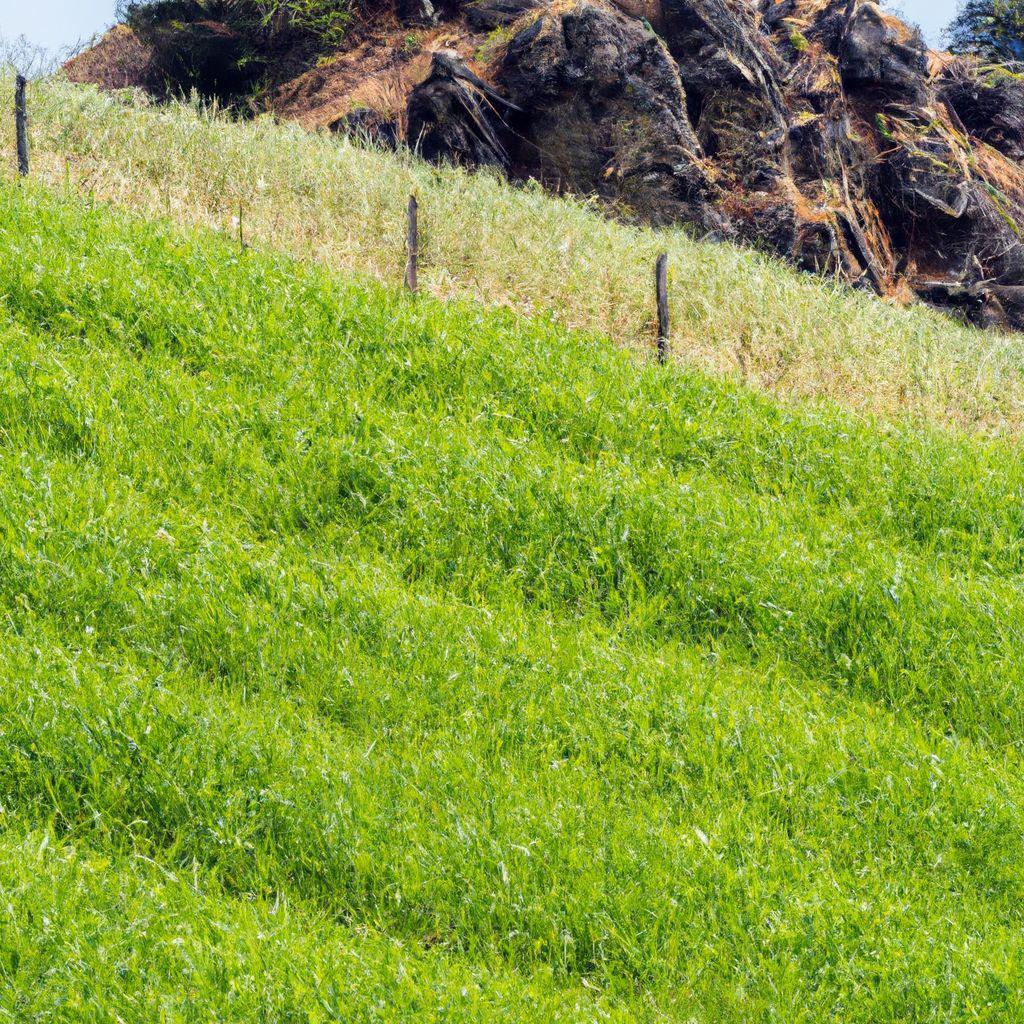Key Takeaway:
- Grasses with fibrous root systems are effective in preventing erosion.
- Sod offers advantages over grass seed for erosion control projects, including creating an instant lawn.
- Various grass types, such as Bermuda grass, Bahia grass, wallaby grass, kangaroo grass, windmill grass, weeping grass, bluegrass, and redgrass, are suitable for erosion control based on their unique characteristics and adaptability to different regions.
- Introduced grasses like Kikuyu grass, couch grass, fescue grass, buffalo grass, and Bahia grass have specific qualities that make them suitable for erosion control in Australia.
- When controlling erosion on slopes, factors such as grass seed selection, native grass effectiveness, alternative ground cover methods, and the use of soil conditioners should be considered.
- Choosing the right grasses and techniques is crucial for effectively preventing erosion and protecting the environment in different regions and conditions.
Introduction
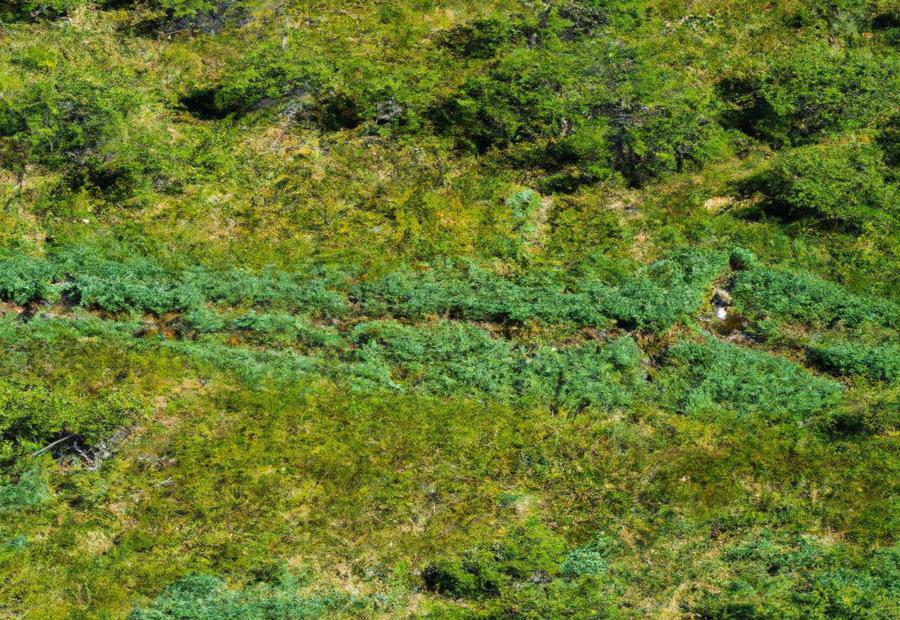
Photo Credits: Gardeninggurus.Org by Ronald Green
Grasses play a crucial role in mitigating erosion, protecting our lands, and maintaining ecological balance. In this section, we’ll explore the significance of erosion control and how grasses serve as nature’s superheroes in preventing soil erosion. We’ll delve into the essential role that grasses play in stabilizing slopes, preventing sediment runoff, and promoting biodiversity. So, let’s uncover the fascinating world of grasses and their important role in erosion control.
Importance of erosion control and the role of grasses
Erosion control is important for maintaining land surfaces’ stability. Grasses help stop erosion with their fibrous root systems which bind soil particles together, preventing them from getting washed away. Grasses offer several advantages for erosion control.
For example, sod is an instant solution. Unlike grass seed, sod gives quick coverage and protection. The root system of sod stabilizes soil on slopes and banks, reducing risk of erosion. Sod also absorbs rainfall better than bare soil, reducing runoff.
In Florida, Bermuda grass is popular due to its fast growth and strong cover. It anchors soil on slopes and banks. Bahia grass is good for controlling erosion on pond banks – it withstands wet and flooded conditions.
In Australia, native grasses are used for erosion control. Kikuyu grass is a good option due to its tolerance to drought, and low cost. Couch grass is good in warm and dry conditions. Fescue grass is known for its density, resistance to drought and disease. Buffalo grass is resilient to drought and saline conditions. Bahia grass thrives in sandy soils and saline conditions, but requires minimal maintenance.
For slope erosion control, native grasses are usually the best choice. They adapt to local conditions and establish strong root systems. Alternately, ground cover methods can be used to prevent soil erosion.
Benefits of Grass for Erosion Control
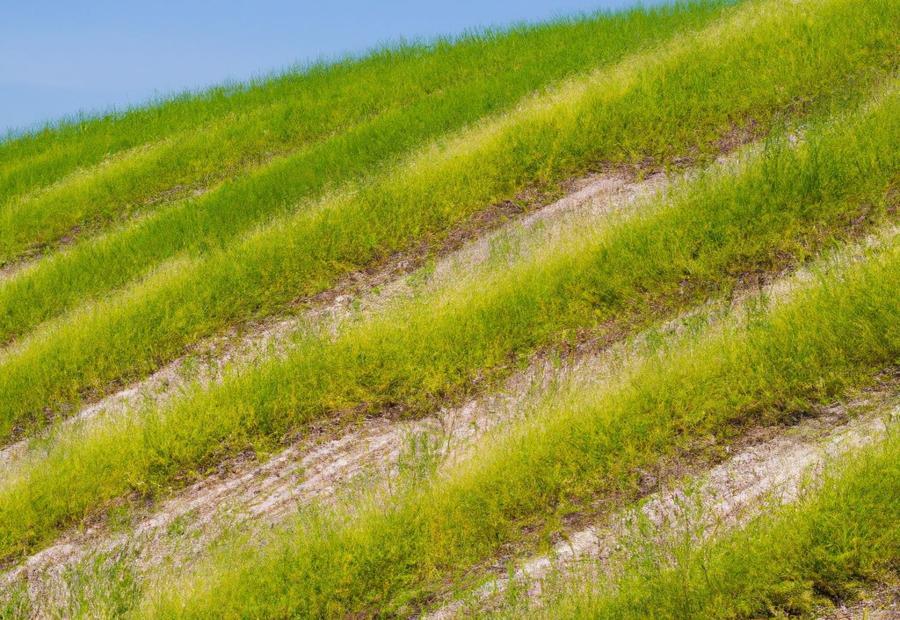
Photo Credits: Gardeninggurus.Org by Robert Brown
Grasses possess remarkable benefits when it comes to erosion control, thanks to their fibrous root system. This sub-section will explore the effectiveness of these roots in preventing erosion, providing stability to the soil, and reducing sediment runoff. According to the reference data, grasses have been proven to significantly decrease soil erosion by up to 90%, making them a crucial tool in combating this environmental threat. Let’s dive deeper into the impressive impact of grasses for erosion control.
Fibrous root system and its effectiveness in preventing erosion
Grasses with fibrous root systems can prevent erosion. Bermuda grass and Bahia grass have many thin roots that spread out and go deep into the soil. This root network holds the soil together, blocking water and wind from washing it away. That’s why grass with fibrous root systems is popular for erosion control projects.
The fibrous roots act as binding agents, gripping the soil particles. This stops rainwater or runoff from eroding the surface. The roots help keep slopes, banks, and other spots safe from erosion.
Grasses with fibrous root systems also help the environment. The network of roots increases soil fertility and moisture retention. It boosts nutrient cycling and infiltration rates. Sod is an instant fix, but grass seeds require patience to nurture and control erosion.
Sod vs. Grass Seed
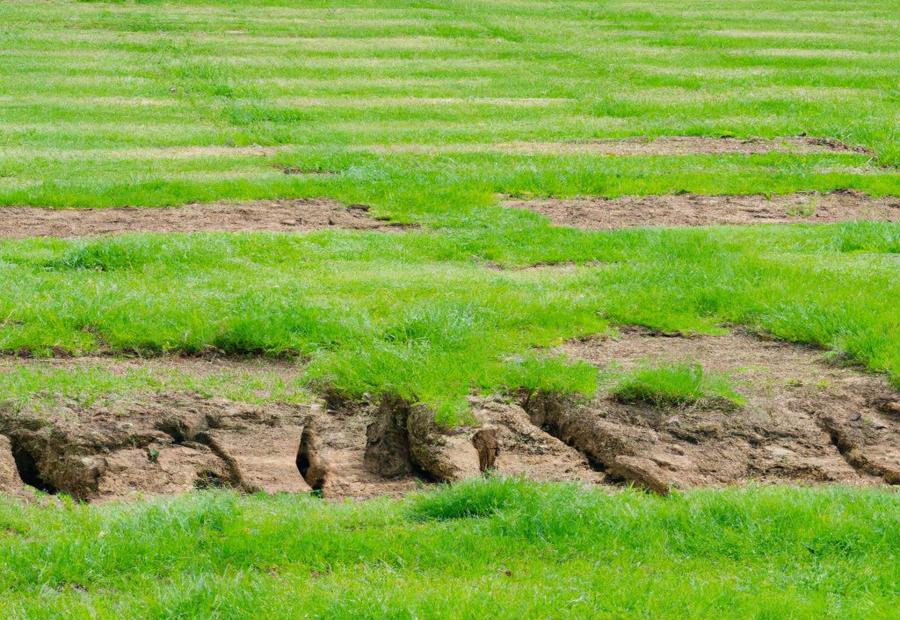
Photo Credits: Gardeninggurus.Org by Christian Baker
When it comes to tackling erosion control projects, the choice between sod and grass seed can make all the difference. Let’s uncover the advantages of sod over grass seed and explore the benefits it brings, including the ability to create an instant lawn.
Advantages of sod over grass seed for erosion control projects
Skip the grass seed and save yourself the hassle – with sod, you can have an instant lawn and a solution to erosion control all in one! Sod provides unique benefits over grass seed for erosion control projects. It’s fast installation process offers an immediate solution with instant coverage. Sod also has a mature root system that binds soil together, retains water efficiently, and prevents weed growth. Plus, it requires less maintenance than growing grass from seed.
Advantages of Sod over Grass Seed for Erosion Control Projects:
- Immediate results with instant coverage
- Mature root system for enhanced erosion prevention
- Efficient water retention capabilities
- Low maintenance requirements
- Prevents weed growth and resource competition
- Quick establishment on slopes or vulnerable areas
- Ensures even coverage with no gaps
Sod is a great choice for efficient and effective erosion control. Enjoy the advantages of instant coverage, enhanced root system effectiveness, reduced maintenance, weed prevention, and consistent coverage without the hassle of growing grass from seed. Invest in sod for your erosion control project and experience the benefits firsthand.
Benefits of using sod, including creating an instant lawn
Sod provides quick, effective erosion control with its fibrous root system. Instantly create a lawn with sod instead of waiting for grass seed to germinate. Enjoy the advantages of an instant lawn that protects soil from further damage.
Root systems hold soil together and defend against runoff. This stops erosion and adds aesthetic value to the landscape. Don’t let nature strip away your soil–use sod for erosion control and enjoy its benefits now!
Grass Types for Erosion Control in Florida
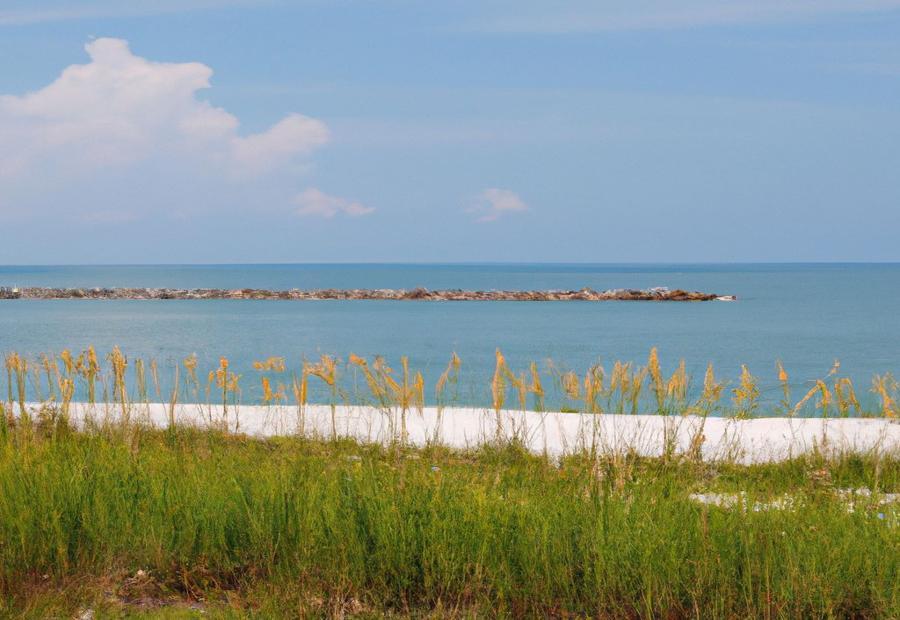
Photo Credits: Gardeninggurus.Org by Jerry Hill
In Florida, different grass types play a vital role in erosion control. One such grass variety is Bermuda grass, known for its popularity in tackling erosion issues. Another effective option is Bahia grass, particularly useful for stabilizing pond banks against erosion. Each grass type offers unique benefits and characteristics that contribute to their effectiveness in combating erosion. Let’s explore why Bermuda grass is favored and how Bahia grass serves as a reliable solution for erosion control in Florida.
Description of why Bermuda grass is popular for erosion control in Florida
Bahia grass: a true superhero of erosion control. It’s dense, fibrous root system effectively binds soil together, making it ideal for use in Florida’s challenging climate and soil conditions. Plus, it spreads quickly to form a thick turf that stabilizes slopes and prevents soil erosion from heavy rains or runoff. Its low-maintenance requirements and ability to tolerate drought and high temperatures make it a perfect choice for erosion control projects in Florida.
Bahia grass can provide immediate protection against erosion upon installation, helping to preserve Florida’s natural beauty. With Bahia grass on your side, you can be sure your pond bank is protected from degradation!
Explanation of how Bahia grass is effective for erosion control on pond banks
Bahia grass is perfect for erosion control on pond banks. It has an impressive root system that penetrates deep into the ground, forming a dense network that holds the soil in place. Plus, it is highly tolerant of dry conditions.
Bahia grass is also great for erosion control because it establishes quickly. This helps to prevent erosion before other plants can be planted. On top of that, it is low maintenance. It requires minimal irrigation and fertilization, making it cost-effective and easy to maintain.
Native Grasses for Erosion Control in Australia
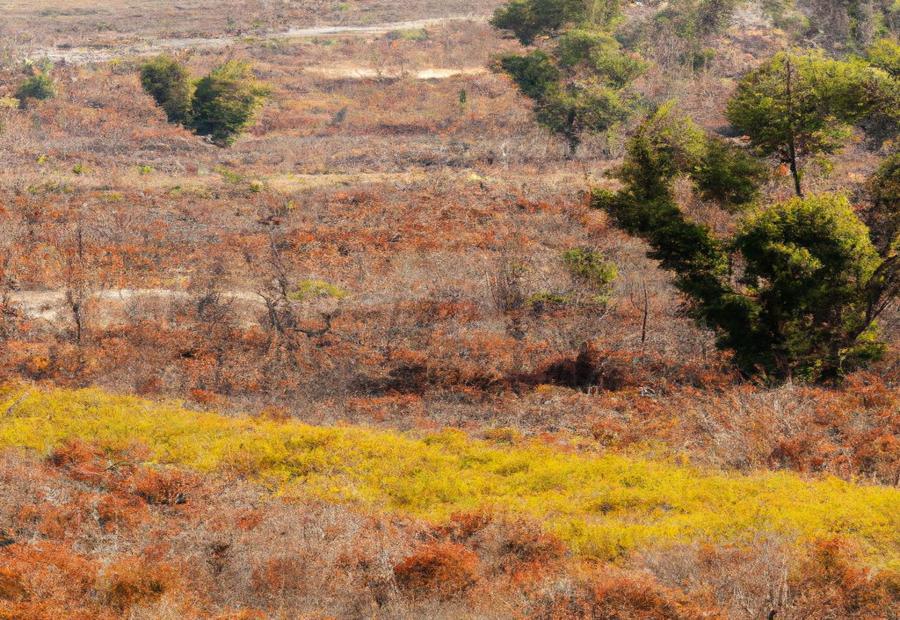
Photo Credits: Gardeninggurus.Org by Tyler Miller
Native grasses play a crucial role in erosion control across Australia. In this section, we’ll explore the unique characteristics of various native grasses and how they contribute to preventing erosion. From the resilience and low maintenance requirements of wallaby grass to the fire resistance and ability to attract insects and birds for fertilization of redgrass, each sub-section will showcase the diverse benefits of these grasses in different environmental conditions.
Resilience and low maintenance requirements of wallaby grass
Wallaby grass is special. It’s resilient and needs little maintenance. This makes it great for erosion control in all kinds of areas. It can withstand harsh conditions and bounce back quickly. It also adapts to different soils, and can even thrive without much water or nutrients.
Wallaby grass is famous for its resilience. It can survive dry periods, and even poor soils. It’s great for places with limited resources. Yet, despite the tough environment, wallaby grass still controls erosion.
Other grasses need a lot of care. Not wallaby grass! Once established, it needs less water and fertilizer than other varieties. Land managers love it because it saves time and effort.
Wallaby grass has a long history in conservation. Indigenous people have used it for centuries to prevent erosion. So by choosing wallaby grass, not only do you protect the environment, but also the cultures that have always cared for it.
Wallaby grass is the perfect choice for land managers. It doesn’t need much maintenance and still stops erosion. Plus, its drought tolerance makes it even better when things get dry.
Drought tolerance and low maintenance of kangaroo grass
Kangaroo grass is renowned for its impressive drought tolerance and low maintenance requirements. It can thrive even in dry conditions, making it a great choice for areas with scarce water or limited rainfall. This grass can endure long periods of drought, without constant watering, conserving water and reducing maintenance effort. Selecting kangaroo grass for erosion control projects can provide a hardy and durable grass that effectively prevents soil erosion, while needing minimal care.
The special qualities of kangaroo grass make it a favored option for places with water shortages or where maintaining a green space is tricky due to limited resources or manpower. This native Australian grass has adapted to arid environments and has evolved to handle extended dry spells. Its deep root system lets it access underground water sources, allowing it to survive in drought conditions. The low maintenance demands of kangaroo grass make it a great pick for places where regular upkeep may not be feasible or practical.
Also, kangaroo grass has extra benefits aside from its drought tolerance and low maintenance needs. It gives essential ground cover, reducing soil erosion by anchoring the soil with its dense root system. Additionally, this resilient grass species can attract birds and insects, aiding the pollination process and supporting biodiversity in the ecosystem. With its ability to grow in nutrient-poor soils, kangaroo grass is a flexible solution that can raise the aesthetic appeal of landscapes while providing effective erosion control.
To sum up, Kangaroo grass offers impressive drought tolerance and requires little maintenance effort. Its capability to live in arid areas makes it a suitable choice for erosion control projects in regions with scarce water or limited resources. This native Australian grass not only prevents soil erosion but also contributes to biodiversity by attracting birds and insects. With its resilience and low upkeep needs, kangaroo grass provides a dependable solution for sustainable landscaping and erosion control initiatives.
Thriving in nutrient-poor areas and arid ranges of windmill grass
Windmill grass is a type of grass that excels in areas with low nutrients and arid conditions. It is adapted to survive in these challenging environments. This grass can grow in nutrient-poor soils, making it perfect for erosion control. Moreover, it can tolerate the dry, arid ranges in some regions, augmenting its usefulness for erosion prevention.
This grass has special features that help it to succeed in nutrient-poor spots and arid ranges. Its deep roots can access water and nutrients from lower soil layers, making it more tough in resource-scarce conditions. Plus, it can go dormant during times of drought, saving energy and water until better conditions come. These traits make it ideal for the difficulties of nutrient-poor soils and arid climates.
Other local or foreign grasses may also adjust well to similar conditions, but windmill grass shows remarkable endurance and efficiency in these particular environments. With its capacity to thrive in nutrient-poor areas and hold up in arid ranges, windmill grass is an invaluable asset for erosion control efforts.
Tolerability to poor soil quality and year-round green appearance of weeping grass
Weeping grass is a special type of grass. It can tolerate poor soil and still look green all year. Also, it has a strong root system which helps hold soil and prevent erosion. It can thrive in soil without much nutrients, making it great for erosion control. Plus, it doesn’t need much care, so it’s an eco-friendly option.
Though, different regions may need different kinds of grass for erosion control. Bluegrass, for instance, prefers deep, rich soil – like a picky eater who only eats the best!
Preference for deep, fertile soils of bluegrass
Bluegrass loves deep, fertile soils – making it perfect for areas with special growth requirements. Its roots can easily penetrate into the ground, so it forms a dense turf. This helps stop erosion.
The main reason bluegrass loves deep soils is its extensive fibrous root system. It can access nutrients from deeper layers and firmly establish itself. The space in the soil lets the roots spread out and anchor the grass. Fertile soil gives bluegrass essential nutrients.
Bluegrass provides other benefits too. Its dense turf protects the underlying soil from rain and runoff. It’s also great for areas with human activity, like parks and sports fields, as it can withstand wear and tear.
In conclusion, bluegrass needs deep, fertile soils for essential nutrients and a healthy environment. It’s perfect for erosion control and offers additional advantages such as resilience and beauty. Wherever the soil is suitable, bluegrass is a great choice for long-term protection against soil loss.
Fire resistance and ability to attract insects and birds for fertilization of redgrass
Redgrass is a grass species with remarkable fire-resistance. It also attracts insects and birds, which helps its fertilization process. This grass provides an extra layer of protection against wildfires. Furthermore, its ability to attract creatures like insects and birds increases its reproductive capabilities as they play a vital role in pollination and seed dispersal.
Redgrass is very useful for erosion control. In regions where wildfires are likely, it serves as an effective barrier, preventing the spread of flames and minimizing damage. Therefore, it is a great choice for areas where erosion control is critical. It stabilizes soil and adds an extra layer of safety against potential fire events.
Apart from fire-resistance, redgrass also attracts insects and birds for fertilization. Insects are attracted to the flowers produced by this grass, aiding in pollen transfer and reproduction. Birds are also drawn to it since they get food sources and nesting materials. These insects and birds contribute to the overall health of redgrass populations.
Redgrass is very valuable for erosion control and wildfire prevention. By using it in vulnerable areas, land managers can protect against soil loss and promote insect pollination and bird interactions. Its resilience makes it an invaluable asset in preserving ecosystems affected by erosion, providing environmental conservation benefits and ecosystem stability.
Introduced Grasses for Erosion Control in Australia
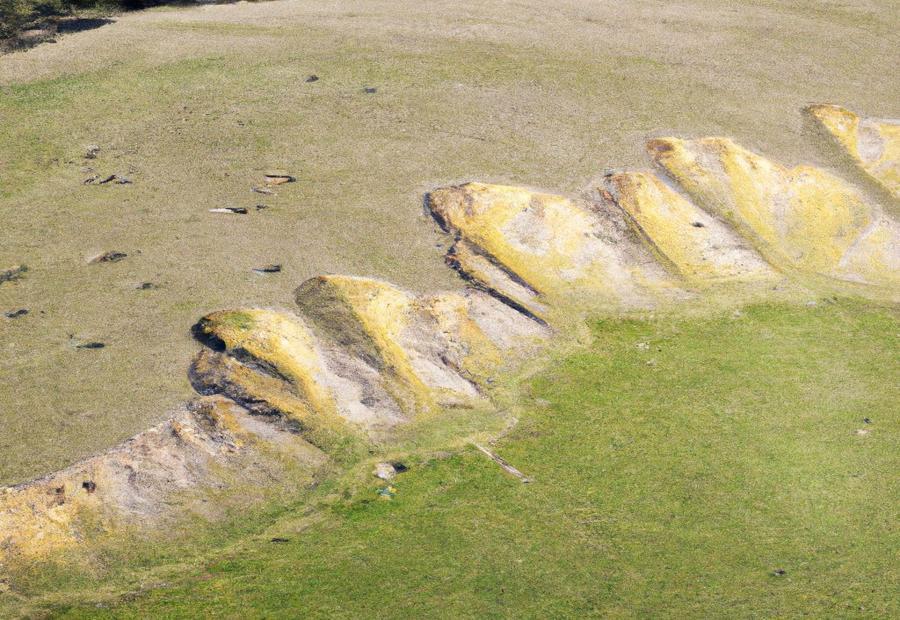
Photo Credits: Gardeninggurus.Org by Stephen Wilson
Introduced Grasses for Erosion Control in Australia: Discover the remarkable features and benefits of Kikuyu grass, couch grass, fescue grass, buffalo grass, and Bahia grass. From low cost and drought tolerance to toughness in warm climates, these grasses offer solutions for erosion challenges. With density, disease resistance, and extreme drought resistance in saline conditions, they provide vital stability to vulnerable areas. Explore how these grasses thrive in various conditions while requiring minimal maintenance.
Low-cost and drought tolerance of Kikuyu grass
Kikuyu grass is perfect for erosion control projects. It’s cheap and can withstand dry conditions. The table below explains its benefits, like cost-effectiveness and drought resistance.
| Benefits of Kikuyu Grass for Erosion Control Projects |
|---|
| Cost-Effectiveness |
| Drought Resistance |
Kikuyu grass has other advantages for erosion control projects. It grows quickly and has a dense growth habit, which helps keep the soil in place. Plus, it can recover quickly from damage or wear.
Given its low cost and drought tolerance, Kikuyu grass is an effective and affordable solution for erosion control projects. Even in harsh climates, it’s a reliable option. Couch grass is also great for hot and dry climates, showing nature’s resilience.
Toughness and ability to thrive in warm, dry climates of couch grass
Couch grass (Elymus repens) is a resilient species with a remarkable ability to thrive in warm, dry climates. Its tough nature withstands harsh environmental conditions. This grass has deep-rooted systems that efficiently extract moisture from the soil, making it drought-resistant.
Couch grass’s adaptive features enable it to survive in arid areas. Its thin and narrow leaves reduce water loss through transpiration. It also has a dense growth habit, providing shade and protection to the soil surface. This conserves water and allows it to grow and survive.
Couch grass can also endure high temperatures. Its internal temperature is regulated by transpiration cooling, allowing it to remain vigorous even on hot summer days.
To maximize couch grass’s effectiveness in warm, dry climates, proper cultivation practices are necessary. Good soil preparation and drainage are crucial. Irrigation during establishment is needed until the roots penetrate the soil. Fertilization enhances the resilience of couch grass by supplying essential nutrients. Mowing at the right heights promotes denser growth and minimizes weed competition.
Overall, couch grass is highly suitable for erosion control in warm, dry climates. With the right understanding and management techniques, lawn care professionals can effectively utilize this species for maintaining healthy landscapes.
Density, drought resistance, and disease resistance of fescue grass
Fescue grass is famed for its thickness, making it look like a lavish carpet. Its dense growth not only looks great, but also prevents soil erosion. Plus, it can survive long dry spells, so it’s perfect for regions without much water. What’s more, fescue grass is resistant to many diseases, meaning it can stay healthy in erosion-prone spots.
Also, fescue grass has great drought resistance. It can thrive even with little water, and is highly resistant to disease. These qualities make fescue grass ideal for erosion control projects in regions that are dry and prone to disease. It is especially useful on slopes and vulnerable terrains, where other vegetation may struggle.
Then there’s buffalo grass, the Superman of grasses, which can handle extreme drought, diseases, and saline conditions. Just like fescue grass, buffalo grass is incredibly resilient.
To sum up, fescue and buffalo grass are excellent at preventing erosion and maintaining environmental stability. They are both highly resistant to drought and disease, and provide effective solutions to various environmental issues.
Extreme drought and disease resistance in saline conditions of buffalo grass
Buffalo grass is renowned for its exceptional resistance to drought and diseases, even in salty soils. This makes it perfect for erosion control projects in areas with scarce water and high salinity. Its ability to survive extreme conditions enables it to survive dry climates, so it’s a reliable option for keeping green ground cover in regions with long droughts. Furthermore, buffalo grass has natural defense mechanisms against diseases, which improves its suitability for erosion control in hard-to-manage environments.
This salt- and drought-tolerant grass variety has been tested and can withstand tough climate conditions, such as saline soils and extended periods of little to no rainfall. Its capacity to adapt and flourish in such situations is a major factor in the success of erosion control efforts. It prevents soil erosion by forming a dense turf that binds the soil particles together and retains moisture in the roots, limiting evaporation and conserving water.
In addition to its remarkable endurance to drought and disease, buffalo grass provides many other advantages. Its deep root system helps improve soil structure by penetrating deeper layers, improving water infiltration and reducing runoff on slopes. Also, it’s low-maintenance, making it a cost-effective choice for erosion control projects as it requires little watering, mowing, and fertilizing compared to other grass varieties.
One example of buffalo grass’s performance in extreme conditions comes from a coastal area with high salinity levels. Traditional grasses were unable to survive due to the salty soil, but after planting buffalo grass, there was significant improvement in preventing erosion along the shoreline. The dense growth of this grass acted as a barrier against wave action and wind, effectively stabilizing the soil and reducing erosion. This example highlights the amazing abilities of buffalo grass in harsh environments and confirms its reputation as a top choice for erosion control efforts in saline areas with limited water.
In comparison, Bahia grass is also a great solution for demanding conditions. It thrives in sandy soils, saline conditions, and requires minimal maintenance.
Tolerance of sandy soils and saline conditions and minimal maintenance of Bahia grass
Bahia grass is perfect for erosion control in difficult environments. It has a special ability to thrive in harsh conditions, unlike other grasses. Low maintenance needs make it a popular option. It can handle sandy soils and saline conditions, thanks to its fibrous roots that bind the soil together. Its dense growth habit also guards against erosive forces like water runoff and wind. Plus, it requires little water and fertilizer, making it cost-effective and eco-friendly. Therefore, Bahia grass is an excellent choice for controlling erosion in various settings. It stands out with its impressive tolerance and low maintenance.
Grasses for Slope Erosion Control
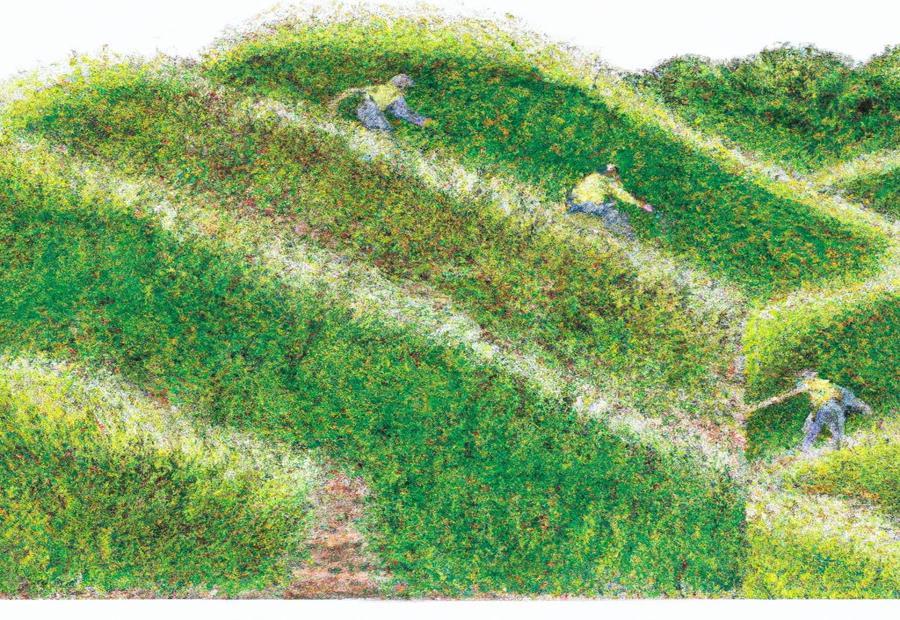
Photo Credits: Gardeninggurus.Org by Bryan Ramirez
Preventing slope erosion is crucial, and using grasses as a natural solution can be highly effective. In this section, we will explore key factors to consider when selecting grass seeds for erosion control on slopes, the proven effectiveness of native grasses, alternative ground cover methods for preventing soil erosion, and the benefits of using soil conditioners to improve seed germination rates. These practical insights will help you make informed decisions, ensuring effective erosion control on challenging slopes.
Factors to consider when selecting grass seeds for slope erosion control
For effective slope erosion control, it is important to choose the right grass seeds. These should have a fibrous root system for soil stabilization. They should be drought tolerant for water runoff areas. And they should have fast growth and excellent coverage.
Local experts can provide guidance on selecting the best grass seeds for a specific site. They consider regional climate factors and site conditions. So seek their advice if needed.
Effectiveness of native grasses for erosion control on slopes
Native grasses are remarkable for erosion control on slopes. They are adapted to their environment and conditions, making them highly effective. Wallaby grass is resilient and requires little maintenance, ideal for erosion-prone slopes. Kangaroo grass is drought-tolerant and low-maintenance. Weeping grass thrives in nutrient-poor areas and looks green all year. Bluegrass works well on slopes with deep, fertile soils. With native grasses, slope stability is improved, and soil erosion is minimized.
Native grasses are essential for slope erosion control. Their fibrous root systems anchor the soil, reducing erosion from water or wind. The roots penetrate the soil layers, providing stability during heavy rain or wind. Grass species suited for slopes, like bluegrass or weeping grass, allow land managers to mitigate erosion risks.
Native grasses not only control slope erosion, but also offer benefits compared to other ground cover methods or non-native species. They need less water and maintenance, plus they provide habitats and food sources for wildlife. Using native grasses on slopes, land managers not only address erosion, but also enhance regional resilience.
A study by the National Park Service shows native grasses reduce erosion rates on slopes more than 50% compared to non-native species. This research emphasizes the importance and effectiveness of native grasses in erosion control, making them key in sustainable land management.
Alternative ground cover methods for preventing soil erosion on slopes
Ground cover plays a huge part in avoiding soil erosion on slopes. Grass is the usual choice, but there are other options!
- Native vegetation: Native plants and grass with deep roots secure soil and stop erosion. They are used to the local climate and soil, so they are great for erosion control.
- Erosion control blankets: Biodegradable mats on slopes help steady the soil, protect from rainfall erosion, and boost vegetation growth.
- Geotextiles or geo-membranes: Synthetic fabrics on slopes stabilize the soil and stop erosion. Impermeable geo-membranes line slopes and stop water getting in.
When picking an alternative ground cover method, you need to think about things like slope gradient, rainfall intensity, and soil characteristics. This makes sure you get long-term protection against soil loss and slope stability.
Plus, give your seeds a fighting chance with soil conditioners – because every seed deserves some love!
Benefits of using soil conditioners for improved seed germination rates
Soil conditioners are essential for better seed germination and erosion control. They make grass seed establishment and growth more successful, creating a strong ground cover.
Here’s how soil conditioners help:
- Enhanced Germination: Soil conditioners improve soil structure and moisture retention, allowing seeds to absorb more water quickly.
- Stronger Root Development: Conditioners provide nutrients and increase soil aeration, resulting in healthy, deep roots that secure the grass.
- Increased Drought Resistance: Conditioners help retain moisture, making grasses more resilient to drought.
- Better Nutrient Availability: Conditioners make essential elements more accessible, so plants can grow healthily and stop erosion.
- Overall Improved Establishment: Conditioners create the best conditions for seed germination and growth, leading to denser vegetation that prevents erosion.
Soil conditioners also assist in establishing vegetation in difficult-to-reach areas. This means erosion control is more successful in keeping soil safe and preserving the environment. It’s possible to prevent erosion and protect the environment, and soil conditioners are a great way to start!
Conclusion
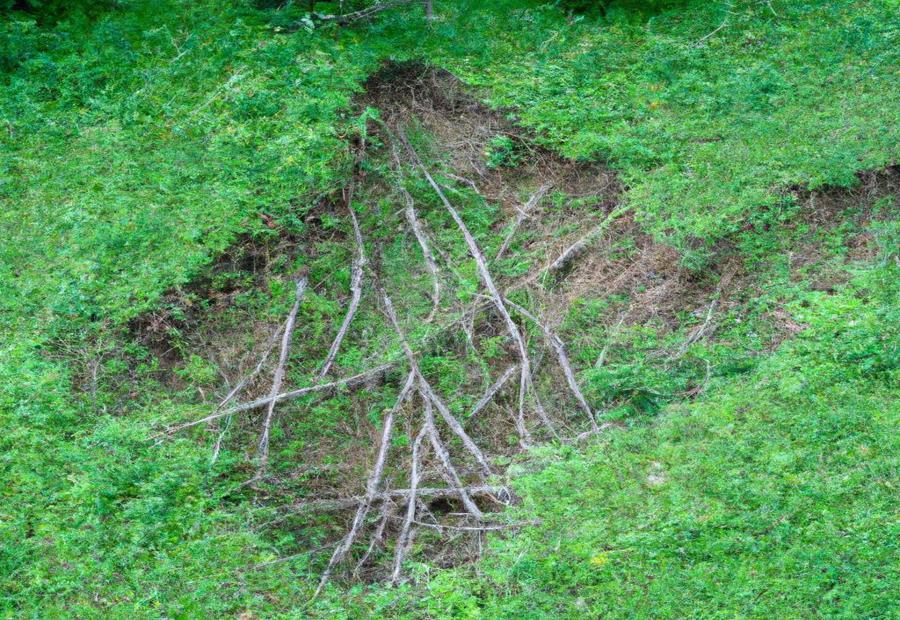
Photo Credits: Gardeninggurus.Org by Anthony Jackson
In the conclusion of this article, we will summarize the various grasses and ground cover options available for erosion control in different regions and conditions. We will also emphasize the importance of selecting the right grasses and implementing effective techniques to prevent erosion and protect the environment.
Summary of grasses and ground cover options available for erosion control in different regions and conditions
Grasses and ground cover options are available for erosion control in various regions and conditions. Native grasses like wallaby, kangaroo, windmill, weeping, bluegrass, and redgrass are options. Introduced grasses such as Kikuyu, couch, fescue, buffalo, and Bahia grass are also effective. Consider soil quality, climate, maintenance requirements, and disease resistance when choosing the right one.
Seed germination rates and native grasses’ effectiveness should be considered when selecting seed for slope erosion control. Alternative ground covers can also be used. Improve seed germination rates with soil conditioners. Windmill and Weeping grass from Australia can tolerate poor soil quality while maintaining a year-round green appearance.
Importance of choosing the right grasses and techniques to effectively prevent erosion and protect the environment.
Choosing the right grasses and techniques is essential for preventing erosion and protecting the environment. Bermuda grass and Bahia grass have fibrous root systems that stabilize the soil. Using sod instead of seed provides instant protection against erosion.
In Australia, native grasses such as wallaby grass, kangaroo grass, windmill grass, weeping grass, bluegrass, and redgrass offer unique advantages. These grasses do not need much maintenance. They attract insects and birds for fertilization and are resistant to fire.
Kikuyu grass provides cost-effective solutions and is drought-tolerant. Couch grass does well in warm and dry climates. Fescue grass is both dense and resistant to drought and disease. Buffalo grass is resistant to drought and saline environments. Bahia grass is low-maintenance and tolerant of sandy soils and saline conditions.
When addressing slope erosion, it is crucial to consider the right grass seeds. Native grasses prevent erosion effectively. However, other methods such as soil conditioners can be used where unique challenges arise. Soil conditioners promote better growth rates.
In conclusion, selecting the right grasses and techniques is key for preventing erosion and protecting the environment. The right choices can make a difference in erosion control efforts.
Some Facts About Grasses For Erosion Control:
- ✅ Grass is an effective and affordable solution for controlling erosion. (Source: Team Research)
- ✅ Grass has a fibrous root system that helps hold the soil in place. (Source: Team Research)
- ✅ Sod is recommended over grass seed for faster results and better soil security. (Source: Team Research)
- ✅ Bermuda grass is a popular choice for erosion control in Florida due to its deep root system and tolerance for difficult conditions. (Source: Team Research)
- ✅ Bahia grass is not aesthetically pleasing but is effective for erosion control, especially on pond banks. (Source: Team Research)
FAQs about Grasses For Erosion Control
1. What is the best grass for erosion control in Florida?
Bermuda grass is a popular choice for erosion control in Florida due to its deep root system and tolerance for difficult conditions. It can effectively hold the soil in place and prevent erosion.
2. Can grass seed be used for erosion control on steep inclines?
Yes, grass seed can be used for erosion control on steep inclines. However, sod is recommended over grass seed for faster results and better soil security.
3. Which grass species are suitable for shade-tolerant lawns?
Fescue grass is a good choice for shade tolerance and is suitable for USDA hardiness zones 3 through 7.
4. How can grass help prevent soil erosion?
Grass has a fibrous root system that helps hold the soil in place, preventing erosion. It also slows and filters runoff, reducing sediment and pollutants that flow into waterways.
5. Are there any native grass species suitable for erosion control?
Yes, there are several native grass species suitable for erosion control. Wallaby grass species, kangaroo grass, windmill grass, weeping grass, and bluegrass are all resilient options for preventing soil erosion.
6. Where can I find more resources and information on erosion control?
For more resources and information on erosion control, you can visit the Green Infrastructure page. They provide additional resources and information on erosion control techniques and solutions.


